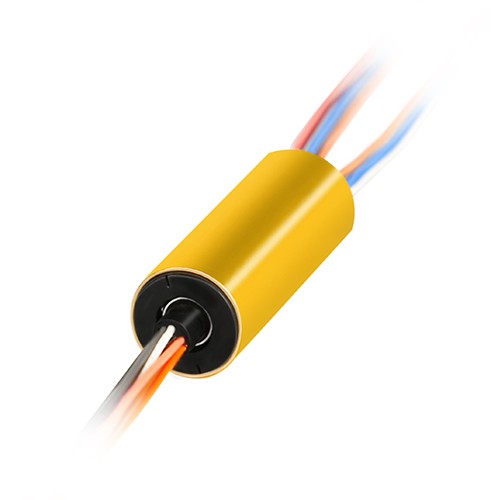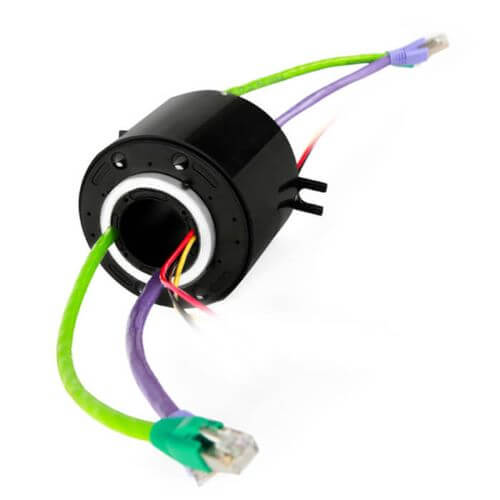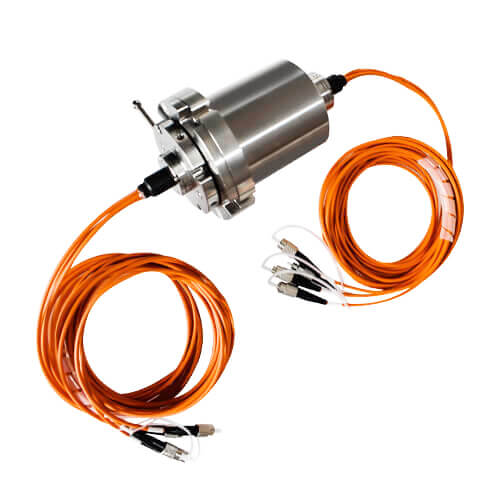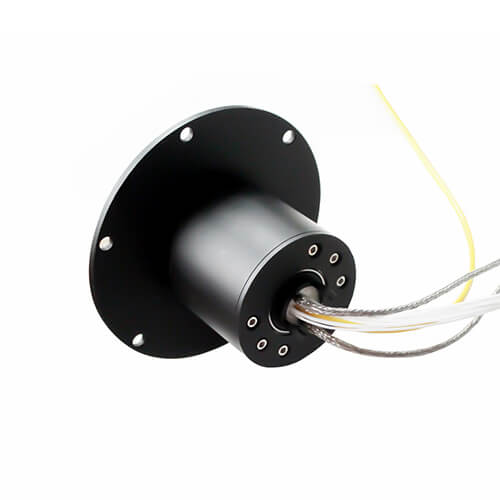In our fast-advancing technological world, security remains a critical concern for both businesses and homeowners. CCTV systems have become the eyes of our modern society, constantly surveilling spaces and safeguarding interests. Among the many components making up these essential systems, slip rings are undoubtedly the unsung heroes.
Our focus in this article is to shed light on these pivotal components, unfolding their core role in CCTV systems, their operations, types, and how slip rings in CCTV applications are transformed by this evolving technology. The purpose of writing this article is manifold; primarily, to offer insights and guidance to individuals and businesses aiming to enhance their understanding of CCTV systems, particularly the function and importance of slip rings.
Furthermore, we aim to inform current users looking to optimize their CCTV systems or those troubleshooting challenges they might be facing. For potential users considering investing in a CCTV system, this article also aims to provide you with thorough knowledge about an essential component, shaping your pre-purchase research and potentially influencing your decision-making process.
As engineering professionals who are involved in the design and manufacturing of slip rings, we bring you an authoritative perspective on this technology. We aim to present information transparently and comprehensively, with the objective of demystifying complex tech aspects and imparting useful knowledge. Through this elaborated discussion of slip rings for CCTV applications, we trust that we can extend the understanding, comfort, and confidence of any reader interacting with these systems.
What you can expect is a wealth of information that has practical applications; for instance, knowing what type of slip ring is ideal for which CCTV setup, how to prolong the lifespan of your slip rings, and how to troubleshoot common issues.
To ensure that this article caters to both the uninitiated and the tech-savvy, we’ve designed it for coherence and clarity. Our intention is to create a resource that respects your valuable time, rewarding your reading with enriched understanding and useful knowledge that holds definite value in your dealings with CCTV applications. Together, let’s unveil the integral role of slip rings and explore how they can best serve your CCTV needs.
Slip Rings in CCTV Applications: The Fundamentals of Slip Rings
In the vast realm of electronics and machinery, slip rings play a pivotal role, seamlessly facilitating the transfer of power and data between components that need to remain in motion relative to each other. To truly appreciate the duties of this silent marvel, we’ll peel back the layers on the fundamentals of slip rings and divulge its integral role in CCTV applications.
A slip ring, in essence, is an electromechanical device that creates an enduring electrical connection between a stationary structure (often referred to as the stator) and a part that rotates (commonly known as the rotor). This kinetic association is crucial in the comprehensive function of many rotating assemblies where continuous power and data transmission are a necessity. The operational crux of a slip ring revolves around its ability to negotiate and mitigate the complications imposed by constant motion without interrupting the circulating electrical signals.
With roots extending across numerous industries and applications—ranging from wind turbines to satellite antennas—slip rings’ importance is universally acknowledged. However, in the landscape of CCTV systems, they assume an added level of significance. CCTV systems are reliant on the smooth operation of cameras, often ones that rotate or pan to surveil diverse angles—these are typically called Pan-Tilt-Zoom (PTZ) cameras. The constant movement of these PTZ cameras could lead to convoluted or constricted wiring, severely impeding their operational efficiency.
Cue in the slip rings, the elegant solution to this challenge. Slip rings nested inside PTZ cameras regulate the transfer of electric signals from the motionless part of the camera to the pivoting part, ensuring continuous and unhindered power supply and transmission of captured footage. By significantly minimizing the risk of wiring complications and offering sustained interruption-free operation, slip rings empower CCTV systems to function with remarkable efficiency and reliability.
In closing this discussion on the fundamentals of slip rings, we hope to have distilled the basic functionality of these devices and their crucial role within CCTV systems. Slip rings, despite their unassuming presence, stand as the unheralded powerhouse behind efficient CCTV applications—a testament to the role ingenuity plays in advancing modern technology.
Importance of Slip Rings in CCTV Applications
As we proceed on our journey delving into the function of slip rings, it is essential to interpret not just what they are or how they work, but equally crucial to understand why they are significant, especially in the perspective of CCTV applications. The escalating demands of surveillance technologies in our modern world and the indispensability of slip rings to fulfill them provide compelling reasons for our exploration.
The function of CCTV systems to provide uninterrupted surveillance is no longer a discretionary necessity but a fundamental requirement. Advanced CCTV cameras today are expected to deliver high-resolution images, capture extended fields of view, and transmit data efficiently, all while operating around the clock. To accomplish such demanding objectives consistently, CCTV systems require robust support from every linked component—and slip rings are instrumental in this.
The role of slip rings in CCTV applications is primarily to maintain electrical continuity between the stationary and rotating parts of the CCTV camera, particularly in Pan-Tilt-Zoom (PTZ) cameras. Their ability to allow freedom of motion, all while transmitting data and power without loss of signal or disconnection, positions them as unique enablers of efficient and effective surveillance.
Imagine a PTZ CCTV camera without a slip ring. The camera struggles with movement, as each rotation risks tangling the wires that power it and transmit data. The camera’s range becomes limited, its operation becomes unreliable, and the risk of system failure increases—essentially, the system’s surveillance capability is significantly hampered. It is the role of the slip ring that allows PTZ cameras to be the comprehensive visual guardians they are, capturing 360-degree views without interruption or mechanical difficulties.
Equally important is the role of slip rings in enabling the transmission of high-resolution and real-time data. Today’s CCTV systems often work in tandem with advanced analytics and AI platforms, which demand high-quality, real-time data to function optimally. Efficient data transmission, which is a fundamental characteristic of slip rings, thus becomes a critical success factor for modern, intelligent CCTV systems.
In essence, the operation of advanced CCTV systems hinges heavily on the efficiency and endurance of slip rings. Their ability to accommodate the demands of continuous rotation, efficient power supply, and fast, reliable data transmission makes slip rings not just an integral part but the backbone of contemporary CCTV systems.
Types of Slip Rings for CCTV Applications
In the dynamic and ever-evolving technological ecosystem, one component seldom fits all applications. Advancing on our exploration of slip rings, we delve into the diverse types that constitute the landscape of these key CCTV elements. By appreciating the distinguishing characteristics of these variants, users can identify and select the best-suited ones for their particular CCTV setups.
Let’s pivot to defining these categories and elucidating how each of them fits uniquely into the broader picture of CCTV systems:
Capsule Slip Rings
These are typically recognized for their compact and lightweight nature. As the name suggests, the capsule slip ring boasts an enclosed structure, protecting the internal circuits and bearings from foreign materials and potential damage. They are perfect for small to medium-sized camera systems where space is at a premium. Although diminutive in size, they deliver reliable power and data transfer, proving that great things often come in small packages.

Pancake Slip Rings
If space-saving is a priority, pancake slip rings take the laurels. Their flat, disc-like design helps in maintaining the low profile of devices. However, their design can limit the number of circuits that fit in the system. They are ideal for a CCTV system with tight space constraints or compact form factors without an extensive need for multiple circuits.

Ethernet Slip Rings
Ethernet slip rings are the future-forward variant, explicitly designed to cater to high-speed data transfer requirements. They are perfect for IP-based CCTV cameras requiring swift data transmission. They keep pace with the fast-evolving digital world and offer superior performance in transferring Ethernet signals without impacting data integrity, enabling real-time video monitoring and ensuring seamless integration with advanced analytics platforms.

Fiber Optic Rotary Joints (FORJs)
Taking high-speed data transmission capabilities to a whole new level, Fiber Optic Rotary Joints (FORJs) are specifically designed for top-tier CCTV systems. Offering minimal signal loss and interference, FORJs deliver unmatched performance for systems that work with very high data rates, catering particularly to high-resolution and real-time video surveillance.

Choosing the right slip ring for a CCTV system boils down to understanding each type’s unique strengths, matching these with the specific needs of the system, and making an informed decision that ensures optimal system performance while anticipating future requirements.
By shedding light on these various types of slip rings, we hope to help you recognize the diversity inherent in this integral component and encourage you towards an informed choice, leading to a CCTV system that truly fits your surveillance needs.
Key Considerations for Choosing an Appropriate CCTV Slip Ring
The journey of choosing the right slip ring for CCTV applications goes beyond a casual stroll in the park. It’s a calculated expedition that requires thoughtful decision-making and wise judgment based on several pivotal factors. These considerations span across system size restrictions, data transmission necessities, environmental factors, and more. This section aims to enlighten you on these factors, equipping you with a comprehensive guideline for selecting the most appropriate slip ring for your CCTV applications.
Device Size and Space Restrictions: One of the primary factors guiding your choice of slip ring is the space available within the CCTV device. For instance, small surveillance cameras might require compact slip rings, rendering capsule slip rings as potential candidates. For systems with space constraints in height but available width, pancake slip rings could be the perfect fit.
Data Transmission Requirements: The desired transmission speed and data quality are contingent on your system requirements. Standard slip rings may suffice for smaller CCTV setups or limited data transmission needs. For IP-based systems or those demanding high-speed and data quality, Ethernet slip rings or Fiber Optic Rotary Joints (FORJs) could be viable choices based on the pace and volume of data transfer required.
Environmental Conditions: The working environment is another significant factor. If the CCTV system is subjected to harsh or uncertain environmental conditions, choosing a slip ring robust against potential harm is crucial. Certain slip rings are designed to resist dust, moisture, and corrosion, making them ideal for outdoor CCTV systems or those exposed to challenging environments.
Power Requirements: The need for power varies with the specifications of the camera system. Some high-quality PTZ cameras need more power for better and faster movements, requiring slip rings capable of transmitting higher electrical currents without overheating or compromising system performance.
System Lifespan and Maintenance: The expected lifespan and maintenance needs of the CCTV system are equally significant elements to consider. Some slip rings exhibit a longer life cycle and require less maintenance than others, seamlessly aligning with the life expectancy of long-term CCTV setups and saving maintenance costs and hassles.
Budget: Last but certainly not least, the budget comes into the picture. Though it is essential to prioritize functionality, system needs and budget often go hand-in-hand. The trick lies in achieving a delicate balance between what you can afford and what you need to meet your CCTV system’s functional requirements efficiently.
Selecting the right slip ring for CCTV applications is an intricate task that involves technical understanding and thoughtful decision-making. By understanding these key considerations, you can ensure that your choice optimally aligns with your surveillance needs, allowing your CCTV system to function with the reliability and efficiency it is designed for.
Slip Rings in CCTV Applications: Common User Concerns and Professional Responses
As professionals engaged in designing and applying slip rings for CCTV systems, we acknowledge that users may have concerns and questions related to these integral components. Our aim here is to address these common inquiries and offer insights to mitigate any apprehensions, enabling our users to make well-informed decisions based on experienced guidance.
Below, we outline and address some prevalent concerns surrounding slip rings in CCTV applications:
Concern 1: Will a slip ring bottleneck the data transmission speed of my CCTV system?
Response: As a responsible developer of slip rings, we take great care in designing these components to ensure they do not bottleneck the data transmission speed. By choosing the right type of slip ring, such as Ethernet slip rings or Fiber Optic Rotary Joints (FORJs) for high-speed data requirements, your CCTV system will typically experience no compromise in data transmission speeds or quality. Rest assured, careful evaluation of your system needs will help select the right slip ring, preventing any potential bottleneck.
Concern 2: How do I determine the lifespan of the slip ring, and will it require frequent maintenance?
Response: Slip rings have varying lifespans depending on their design, construction, and the specific operating environment. High-quality slip rings are built to offer an extended lifespan—some with a life expectancy of millions of rotation cycles under typical operating conditions. The use of advanced materials and precision engineering further enhances their durability. To ensure a long-lasting performance, always invest in a trustworthy manufacturer’s slip rings, and adhere to their maintenance recommendations. This will greatly reduce any frequent maintenance concerns.
Concern 3: Can slip rings withstand harsh environmental conditions (dust, moisture, temperature variations, etc.)?
Response: Many slip rings are specifically designed to withstand challenging environmental conditions. These products feature robust construction and materials, ensuring protection against dust, moisture, corrosion, and wide temperature fluctuations. When selecting a slip ring for your CCTV application, it is crucial to pay attention to these specifications and ensure compatibility with your intended operating environment.
Concern 4: How do I ensure my chosen slip ring is compatible with the existing CCTV system components (power supply, connectors, etc.)?
Response: The key to ensuring compatibility between your slip ring and existing CCTV components lies in thoroughly understanding the system requirements and specifications of individual parts. Before purchasing a slip ring, consult user manuals for power requirements, connector types, and other parameters. Should you have concerns or feel unsure, seek support from professionals to help guide you through the selection process.
Concern 5: Can the use of slip rings introduce any electrical noise or interference in my CCTV system?
Response: High-quality slip rings are engineered to minimize electrical noise and interference, ensuring stable, smooth connections for your CCTV system. To minimize such issues, opt for well-regarded manufacturers and their product lines, as their focus typically lies in providing reliable slip rings that meet industry standards.
By addressing these common user concerns, we strive to provide reassurance and guidance backed by industry experience. We believe that by demystifying slip rings and their role in CCTV applications, users can embrace the technology with confidence to maximize the potential of their surveillance systems.
The Impact of Technological Advancements on CCTV Slip Rings
In the grand narrative of technological progression, even the most minute or seemingly inconspicuous components do not stand untouched. Slip rings, vital components of CCTV systems, are prime examples of such evolution. Throughout the years, they have undergone significant transformations, fueled by technological advancements and the escalating demands of CCTV systems. Here, we reflect on how the path of innovation has shaped slip rings and provide a glimpse into the future trends projected to further mold this panorama.
The Evolution Influenced by Technological Advancements
Traditionally, slip rings were simple electro-mechanical devices enabling the transmission of power and baseband video signals across rotating interfaces. However, the pivot of CCTV systems from analog to IP-based digital systems has dictated a radical transformation in slip ring technology.
This shift has ushered in Ethernet slip rings, designed specifically to cater to the high-speed, reliable data transmission needs of IP-based CCTV systems. They ensure the transmission does not impact data integrity, thereby enabling real-time video monitoring and seamless integration with advanced analytics platforms. Ethernet slip rings reflect the intersection of slip ring innovation and the evolving needs of CCTV systems.
Similarly, the need for even faster and more sophisticated data transfer capabilities led to the advent of Fiber Optic Rotary Joints (FORJs). Engineered for systems that work with extremely high data rates, FORJs operate with minimal signal loss and interference, thereby catering to the high demand for real-time, high-resolution video surveillance.
Peering into the Future of Slip Ring Technology
We stand at the cusp of an exhilarating era where technological advancements are accelerating at a pace like never before. Based on the emergent trends, the future of slip ring technology seems to be steering towards even higher efficiency, durability, and intelligence.
- Greater Capacity and Speed: As data-intensive applications burgeon, the demand for higher-capacity slip rings will increase. We anticipate more specialized high-speed data slip rings that can handle larger amounts of data seamlessly.
- Miniaturization: With electronics becoming smaller and CCTV systems favoring sleek designs, the demand for smaller, lightweight, yet powerful slip rings is on the rise. Future slip rings will likely continue this trend towards miniaturization without compromising performance.
- Intelligent Features: Given the trend towards smart technology, we can expect future slip rings to house intelligent features such as self-diagnostic capabilities, enabling users to rectify any issues thereby avoiding operational interruptions.
- Environmentally Robust Designs: As CCTV systems’ application expands to more challenging environments, the need for slip rings with increased resistance against extreme temperature, humidity, and other harsh conditions will rise.
The journey of slip rings from a basic component to a part fastidiously reflecting technological advancements is a testament to the dynamic nature of the field. By keeping pace with these cutting-edge developments, you can ensure your CCTV system’s integral components are always at the forefront of innovation, thereby driving optimized performance and future readiness.
Conclusion
In conclusion, understanding the fundamentals of slip rings, the benefits they bring to CCTV systems, and addressing user concerns is essential when implementing these devices. By staying informed and making informed choices, users can ensure the optimal operation of their CCTV systems, all while benefiting from the professional expertise of slip ring manufacturers and designers.
See What We Can Do


